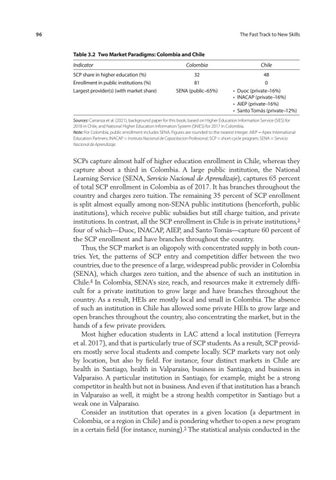96
The Fast Track to New Skills
Table 3.2 Two Market Paradigms: Colombia and Chile Indicator SCP share in higher education (%) Enrollment in public institutions (%) Largest provider(s) (with market share)
Colombia
Chile
32 81 SENA (public–65%)
48 0 • Duoc (private–16%) • INACAP (private–16%) • AIEP (private–16%) • Santo Tomás (private–12%)
Sources: Carranza et al. (2021), background paper for this book, based on Higher Education Information Service (SIES) for 2018 in Chile, and National Higher Education Information System (SNIES) for 2017 in Colombia. Note: For Colombia, public enrollment includes SENA. Figures are rounded to the nearest integer. AIEP = Apex International Education Partners; INACAP = Instituto Nacional de Capacitacion Profesional; SCP = short-cycle program; SENA = Servicio Nacional de Aprendizaje.
SCPs capture almost half of higher education enrollment in Chile, whereas they capture about a third in Colombia. A large public institution, the National Learning Service (SENA, Servicio Nacional de Aprendizaje), captures 65 percent of total SCP enrollment in Colombia as of 2017. It has branches throughout the country and charges zero tuition. The remaining 35 percent of SCP enrollment is split almost equally among non-SENA public institutions (henceforth, public institutions), which receive public subsidies but still charge tuition, and private institutions. In contrast, all the SCP enrollment in Chile is in private institutions,3 four of which—Duoc, INACAP, AIEP, and Santo Tomás—capture 60 percent of the SCP enrollment and have branches throughout the country. Thus, the SCP market is an oligopoly with concentrated supply in both countries. Yet, the patterns of SCP entry and competition differ between the two countries, due to the presence of a large, widespread public provider in Colombia (SENA), which charges zero tuition, and the absence of such an institution in Chile.4 In Colombia, SENA’s size, reach, and resources make it extremely difficult for a private institution to grow large and have branches throughout the country. As a result, HEIs are mostly local and small in Colombia. The absence of such an institution in Chile has allowed some private HEIs to grow large and open branches throughout the country, also concentrating the market, but in the hands of a few private providers. Most higher education students in LAC attend a local institution (Ferreyra et al. 2017), and that is particularly true of SCP students. As a result, SCP providers mostly serve local students and compete locally. SCP markets vary not only by location, but also by field. For instance, four distinct markets in Chile are health in Santiago, health in Valparaíso, business in Santiago, and business in Valparaíso. A particular institution in Santiago, for example, might be a strong competitor in health but not in business. And even if that institution has a branch in Valparaíso as well, it might be a strong health competitor in Santiago but a weak one in Valparaíso. Consider an institution that operates in a given location (a department in Colombia, or a region in Chile) and is pondering whether to open a new program in a certain field (for instance, nursing).5 The statistical analysis conducted in the

